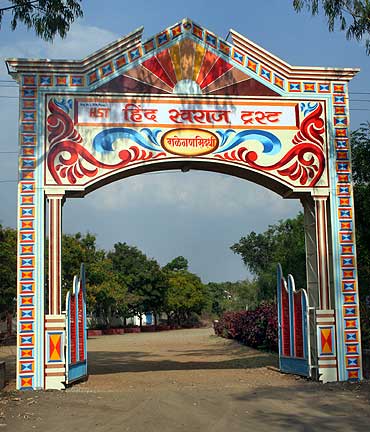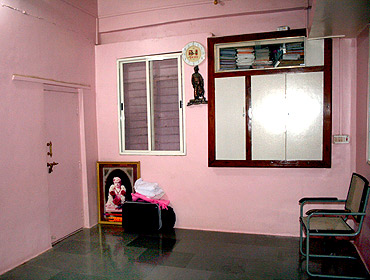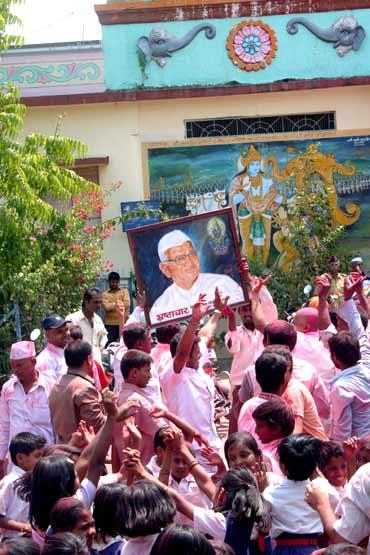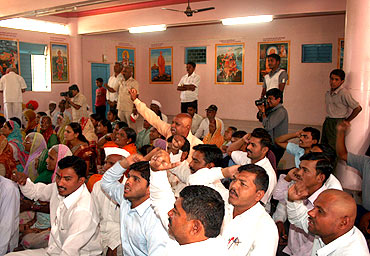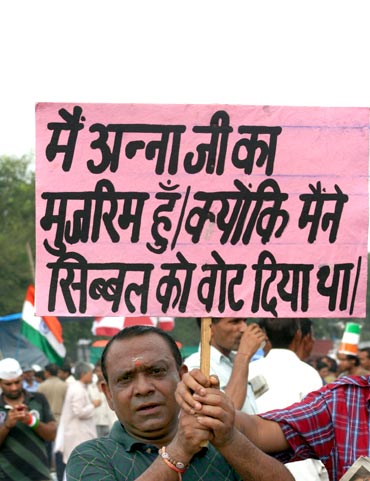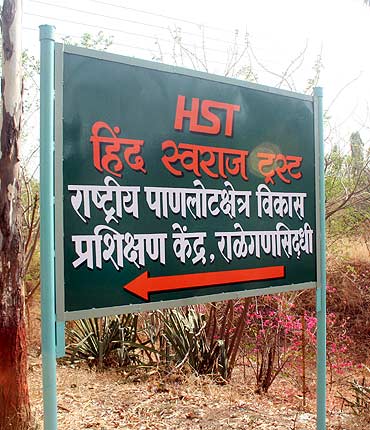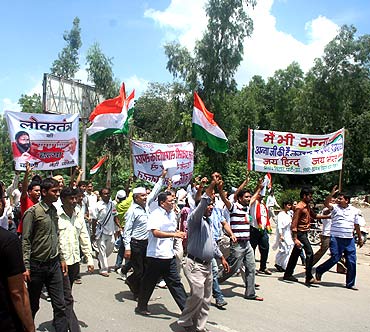 | « Back to article | Print this article |
Ralegan to Ramlila: Anna Hazare's long journey
Prasanna D Zore reports from Ralegan Siddhi on the journey of an ordinary man from a modest village in Maharashtra to the Ramlila Maidan in Delhi, where his indefinite fast has brought the government to its knees.
Nobody in Ralegan Siddhi knows how and when Kisan Baburao Hazare became 'Anna' Hazare. But the moniker has stuck to his name for decades now, say the people of his hometown. Anna, as he is affectionately called by his followers across the country now, means elder brother in Marathi, the language Hazare speaks.
Nobody knew much about Hazare till about 1975 when he quit the Indian Army, inspired by Swami Vivekananda's philosophy, and returned home to spend his life for the cause of society and rural development.
Soon, though, his fight against prohibition and for the causes of women empowerment and rural development, with a focus on management of watershed areas, began to see a steady stream of supporters enlisting themselves to Hazare's cause.
Please click on NEXT to read further...
How Hazare became a local hero
Hazare's most potent weapon to make the political class accept his demands has been a fast-unto-death, according to one of his close aides who is currently camping in Delhi.
Hazare staged his first fast-unto-death in June 1980, to seek a government grant for the school he later set up -- the Shri Sant Nilobarai Vidyalaya.
Hazare broke his fast within two hours, after the Maharashtra government sent its emissary Balasaheb Bharde, a former speaker of the state legislative assembly and later a cabinet minister.
"Within two hours of starting that fast, the government accepted Anna's demand in writing," says Thakaram Laxman Raut, who was appointed as the school principal on October 26, 1980. After his retirement in 2002, he has become a member of Anna Hazare's Hind Swaraj Trust. Ever since Raut joined the school, he has closely followed all the agitations led by Hazare.
This one agitation set the stage for what Hazare had vowed to do and gave the people of Ralegan Siddhi a hero they could look up to. The roots of 'Anna the legend' began to take shape in mid 1980s.
Please click NEXT to read further.
Hazare becomes a hero for local farmers
Word about the activist, and Hazare's appeal, soon spread.
Here was a modest man who left the military to work for the people, spent his retirement fund and invested efforts to reconstruct a dilapidated village temple, brought about voluntary prohibition in Ralegan Siddhi, converted an arid village into a sea of green through his watershed development programmes, left his family home so that he could make the village his family.
Hazare was just 42 then. He was born on June 15, 1938.
In 1984 he began his second fast-unto-death for the rights of farmers in the state. Hazare called off his fast within three days after the government passed a resolution to provide grants for both agricultural and horticultural activities for the farmers. Earlier, farmers could avail only one of the grants.
"The governments then would not test Anna's patience so much," says one of Hazare's aides in New Delhi, while comparing the 1984 fast with the ongoing fast at the Ramlila Maidan, which entered its 11th day on Friday.
Please click NEXT to read further.
'You should have seen the adulation'
While this agitation strengthened the support of farmers for Hazare, his leadership was put to the test during an agitation of farmers, who demanded that there should be no drop in voltage fluctuation for the time they did receive power supply.
Sudden drops in voltage fluctuations -- and nobody was complaining about power cuts -- damaged electric pumps that the farmers used to draw water from their wells.
"Hazare became the messiah of the farmers when he led their agitation demanding no voltage fluctuation," says Raut.
"The farmers' wells were brimming with water, but they there was no proper supply of electricity to pump this water into their fields. This damaged their standing crops leading to financial losses," Raut says, explaining the grouse of the farmers in nearly 20 villages around Ralegan Siddhi.
"When Anna began his fast-unto-death," says Raut, "thousands of villagers came out on the streets and blocked the roads."
The police resorted to firing and four farmers paid with their lives. This made the government take cognisance of the problem and in nearly 15 days, proper electric supply was restored in these villages.
"You should have seen the adulation and esteem that Anna started commanding from the farmers after this agitation," adds Raut.
Please click NEXT to read further.
Hazare takes on ministers
Hazare's first struggle against corruption occurred the same year when he exposed the mismanagement of social forestry funds worth Rs 3 crore (Rs 30 million) in the purchase of heavy machinery by government officials and contractors. More than 40 government officials and contractors were either dismissed or suspended from service.
Hazare's emergence as an anti-corruption crusader became evident only in 1997 when he took on three ministers -- Shashikant Sutar, Baban Gholap and Mahadeo Shivankar -- in the Shiv Sena-Bharatiya Janata Party coalition government. All three ministers eventually stepped down from office.
Interestingly, Hazare converted his movement against corruption into an institution when he formed the Brashtachar Virodhi Jan Andolan (Anti-Corruption People's Movement) that encouraged people to take on corruption by appointing local vigilantes who exposed corruption in various political and social schemes of the government.
This move attracted much criticism when BVJA members were found to be involved in cases of corruption and blackmail.
That did not deter Hazare from taking on the political establishment. On August 9, 2003 (August 9 was the day when Mohandas Karamchand Gandhi launched the Quit India movement in 1942) Hazare began a fast-unto-death that lasted 11 days at Mumbai's Azad Maidan to protest against the state government's dilly-dallying against the enactment of the Right to Information Act in Maharashtra.
"On the 12th day, the government buckled under pressure and got the Act signed by the President of India," says Dattatraya Awari, a member of Hazare's BVJA since 2003 and a resident of Ralegan Siddhi.
The same year, Hazare took on for four more Maharashtra ministers -- Sureshdada Jain, Nawab Malik, Vijay Kumar Gavit and Padamsinh Patil -- of the Congress-Nationalist Congress Party government. While Jain resigned after being indicted by a government-appointed commission, Malik resigned in the wake of Hazare's fast.
Please click NEXT to read further.
How Hazare came to lead the anti-corruption movement
Hazare's pro-farmer agitation brought him into the national limelight. The scores of agitations he led at the village level, his idea of converting villages into ideal villages and his innovative ideas in the area of watershed development programmes were noticed by various state governments.
States like Andhra Pradesh, Madhya Pradesh, Rajasthan, Himachal Pradesh and Odisha appointed Hazare as a member of their respective state planning commissions.
"While attending meetings of these state bodies Hazare came into contact with activists including Arvind Kejriwal, Kiran Bedi and Aruna Roy," says Hazare's aide, speaking on the telephone from New Delhi.
"Arvind and Anna would discuss at length the issue of corruption and effective ways of tackling it," says this aide.
Kejriwal visited Ralegan Siddhi thrice between 2007 and 2010, he adds, to discuss the contours of an effective Jan Lokpal Bill with Hazare.
Hazare, who had heard about Swami Agnivesh, Shanti Bhushan, Prashant Bhushan and Justice Santosh Hegde as individuals of integrity, had a chance to interact with them during his visits to Delhi and different parts of the country.
Please click NEXT to read further.
'Anna was chosen because of his standing'
"The issues these people discussed would always revolve around corruption," says Hazare's aide.
"Sometime in November-December 2010, Kejriwal took the initiative to bring this group together," he adds.
Once it was agreed that a Jan Lokpal Bill could help curb corruption, the activists held public meetings across the country, explaining the benefits of having a strong Lokpal. They also spoke about how various governments at the Centre had vacillated in making the Lokpal a reality.
"After assessing the public mood, these people realised that the nation was ready for a mass movement," says Raut of Ralegan Siddhi.
While most activists in this group were convinced of mass support, the one issue paramount to them was leadership of the movement.
"After thoughtful consideration, they requested Anna to lead the movement," says his aide.
"Anna was chosen because of his standing as a man of honesty, integrity and incorruptibility," he adds.
Please click NEXT to read further.
'He fasted for 11 days, surviving only on water'
The fact that Hazare had led campaigns using the Gandhian method of satyagraha as his primary weapon convinced Kiran Bedi, Arvind Kejriwal and Prashant Bhushan that he could become a rallying point for the masses.
"The longest Anna had fasted was when he had held a hunger strike for the enactment of Maharashtra RTI," says the Hazare aide, speaking from New Delhi.
"He fasted for 11 days, surviving only on water, and the government surrendered. They knew only Anna could sustain such a mass movement for a long time despite his fast," he says.
Once the nitty-gritty of the movement was finalised, Hazare met Prime Minister Manmohan Singh in February to apprise him about the national sentiment against corruption.
When the anti-corruption leaders realised that the Union government was not serious about tackling the issue, Hazare wrote Dr Singh a letter on March 13, informing the prime minister about his intention to start an agitation and embark on a fast-unto-death for the enactment of a strong Lokpal.
Please click NEXT to read further.
History in the making?
"When his letter did not elicit any response, Anna began his fast-unto-death at Jantar Mantar on April 4," says Raut.
Hazare broke his fast on the fifth day after the government accepted his request to constitute a panel to draft the Lokpal Bill, as per his demand, and the logjam was broken.
History, however, had something else in store for Hazare.
The panel that had an equal number of members from the government and 'Team Anna' could not agree on various contentious issues including the inclusion of the prime minister's office, the judiciary and the lower bureaucracy under the Lokpal.
"Anna," adds his aide, "had to once again resort to a fast-unto-death so that a strong authority of the Lokpal comes into existence."
